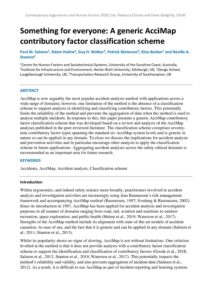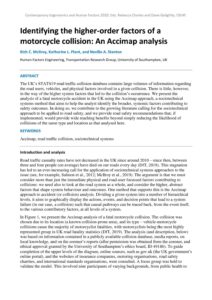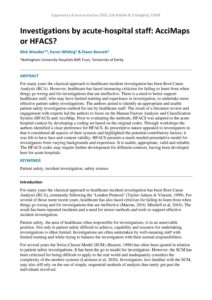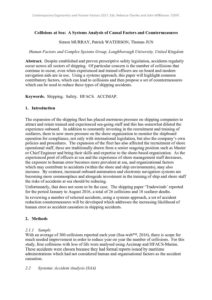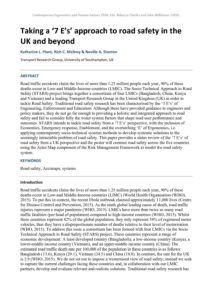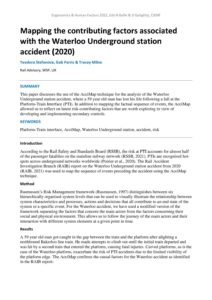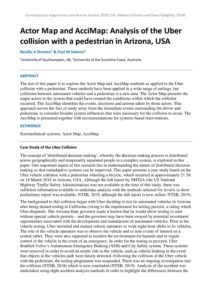Accimaps
Something for everyone: A generic AcciMap contributory factor classification scheme
| Document | Author Paul M. Salmon, Adam Hulme, Guy H. Walker, Patrick Waterson, Elise Berber and Neville A. Stanton |
| Abstract AcciMap is now arguably the most popular accident analysis method with applications across a wide range of domains; however, one limitation of the method is the absence of a classification scheme to support analysts in identifying and classifying contributory factors. This potentially limits the reliability of the method and prevents the aggregation of data when the method is used to analyse multiple incidents. In response to this, this paper presents a generic AcciMap contributory factor classification scheme that was developed based on a review and analysis of the AcciMap analyses published in the peer-reviewed literature. The classification scheme comprises seventy-nine contributory factor types spanning the standard six AcciMap system levels and is generic in nature so can be applied in any domain. To close we discuss the implications for accident analysis and prevention activities and in particular encourage other analysts to apply the classification scheme in future applications. Aggregating accident analyses across the safety critical domains is recommended as an important area for future research. |
Identifying the higher-order factors of a motorcycle collision: An Accimap analysis
| Document | Author Rich C. McIlroy, Katherine L. Plant and Neville A. Stanton |
| Abstract The UK’s STATS19 road traffic collision database contains large volumes of information regarding the road users, vehicles, and physical factors involved in a given collision. There is little, however, in the way of the higher system factors that led to the collision’s occurrence. We present the analysis of a fatal motorcycle accident in the UK using the Accimap approach, a sociotechnical systems method that aims to help the analyst identify the broader, systemic factors contributing to safety outcomes. In doing so, we contribute to the growing literature calling for the sociotechnical approach to be applied to road safety, and we provide road safety recommendations that, if implemented, would provide wide reaching benefits beyond simply reducing the likelihood of collisions of the same type and location as that analysed here. |
Investigations by acute-hospital staff: AcciMaps or HFACS?
| Document | Author Nick Woodier, Karen Whiting & Owen Bennett |
| Abstract For many years the classical approach to healthcare incident investigation has been Root Cause Analysis (RCA). However, healthcare has faced increasing criticism for failing to learn from when things go wrong and for investigations that are ineffective. There is a need to better support healthcare staff, who may have limited training and experience in investigation, to undertake more effective patient safety investigations. The authors aimed to identify an appropriate and usable patient safety investigation method for use by healthcare staff. The result of a literature review and engagement with experts led the authors to focus on the Human Factors Analysis and Classification System (HFACS) and AcciMap. Prior to evaluating the methods, HFACS was adapted to the acute hospital context by developing a coding set based on the original codes. Through workshops the authors identified a clear preference for HFACS. Its prescriptive nature appealed to investigators in that it considered all aspects of their systems and highlighted the potential contributory factors; it was felt to have face and content validity. HFACS presents a much-needed prescriptive model for investigators from varying backgrounds and experience. It is usable, appropriate, valid and reliable. The HFACS codes may require further development for different contexts, having been developed here for acute hospitals. |
Collisions at Sea: A Systems Analysis of Causal Factors and Countermeasures
| Document | Author Simon MURRAY, Patrick WATERSON, Thomas JUN |
| Abstract Despite established and proven prescriptive safety legislation, accidents regularly occur across all sectors of shipping. Of particular concern is the number of collisions that continue to occur, even when experienced and trained officers are on board and modern navigation aids are in use. Using a systems approach, this paper will highlight common contributory factors, which can lead to collisions and then propose a set of countermeasures which can be used to reduce these types of shipping accidents. |
Taking a ‘7 E’s’ approach to road safety in the UK and beyond
| Document | Author Katherine L. Plant, Rich C. McIlroy & Neville A. Stanton |
| Abstract Road traffic accidents claim the lives of more than 1.25 million people each year, 90% of these deaths occur in Low-and Middle-Income countries (LMIC). The Socio Technical Approach to Road Safety (STARS) project brings together a consortium of four LMICs (Bangladesh, China, Kenya and Vietnam) and a leading Transport Research Group in the United Kingdom (UK) in order to tackle Road Safety. Traditional road safety research has been characterised by the ‘3 E’s’ of Engineering, Enforcement and Education. Although these have provided guidance to engineers and policy makers, they do not go far enough to providing a holistic and integrated approach to road safety and fail to consider fully the wider system factors that shape road user performance and outcomes. STARS intends to tackle road safety from a ‘7 E’s’ perspective, with the inclusion of Economics, Emergency response, Enablement, and the overarching ‘E’ of Ergonomics, i.e. applying contemporary socio-technical systems methods to develop systemic solutions to the seemingly intractable problem of road safety. This paper provides a status review of the ‘7 E’s’ of road safety from a UK perspective and the poster will contrast road safety across the five countries using the Actor Map component of the Risk Management Framework to model the road safety system. |
Mapping the contributing factors associated with the Waterloo Underground station accident (2020)
| Document | Author Teodora Stefanova, Gab Parris & Tracey Milne |
| Abstract This paper discusses the use of the AcciMap technique for the analysis of the Waterloo Underground station accident, where a 59 year old man has lost his life following a fall at the Platform-Train Interface (PTI). In addition to mapping the factual sequence of events, the AcciMap allowed us to reflect on latent risk-contributing factors that are worth exploring in view of developing and implementing secondary controls. |
Actor Map and AcciMap: Analysis of the Uber collision with a pedestrian in Arizona, USA
| Document | Author Neville A. Stanton & Paul M. Salmon |
| Abstract The aim of this paper is to explore the Actor Map and AcciMap methods as applied to the Uber collision with a pedestrian. These methods have been applied in a wide range of settings, but collisions between automated vehicles and a pedestrian is a new area. The Actor Map presents the major actors in the system that could have created the conditions within which the collision occurred. The AcciMap identifies the events, decisions and actions taken by those actors. This approach moves the foci of study away from the immediate events surrounding the driver and pedestrian, to consider broader system influences that were necessary for the collision to occur. The AcciMap is presented together with recommendations for systems-based interventions. |

